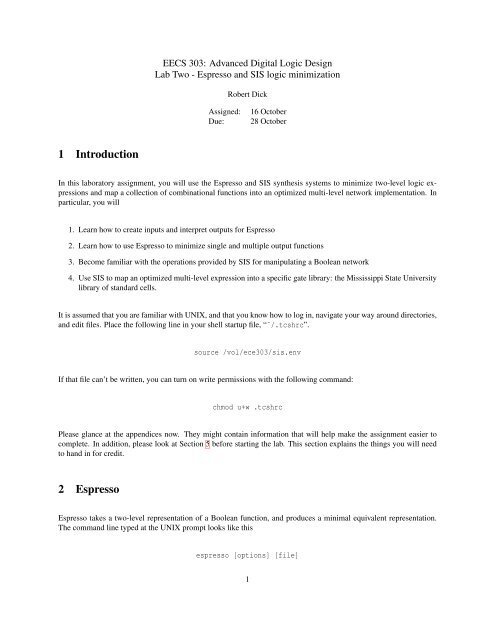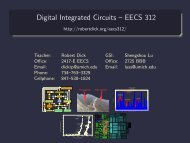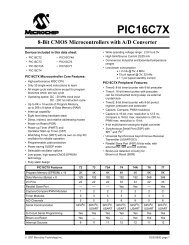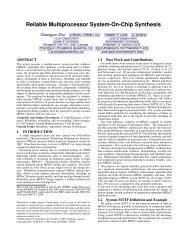1 Introduction 2 Espresso
1 Introduction 2 Espresso
1 Introduction 2 Espresso
Create successful ePaper yourself
Turn your PDF publications into a flip-book with our unique Google optimized e-Paper software.
sis> exitWe will run through the multi-level optimization of the full adder. It is a good idea to create your own input file andfollow this example step by step by typing the same commands at the keyboard.First, we will create an equation file for the full adder in the format expected by the Eqntott program. Eqntott can beused to convert from equations to truth tables for use in <strong>Espresso</strong>. However, SIS can read in equation files directly. Wewill create a Unix file named “full-adder.eqn”. Inside the file we type two lines as follows:cout = a * b * ci + a * b * ci’ + a * b’ * ci + a’ * b * ci ;sum = a * b * ci + a * b’ * ci’ + a’ * b * ci’ + a’ * b’ * ci ;We can also omit the “*” sign and type this ascout = a b ci + a b ci’ + a b’ ci + a’ b ci ;sum = a b ci + a b’ ci’ + a’ b ci’ + a’ b’ ci ;However, be sure not to omit the spaces between the ANDed variables. Without them, SIS would treat abc as a singlemulti-character variable name instead of a product.Save the file and exit your text editor. In the Eqntott input file, equations lines have the following format:[signal] = [expr] ;You can use the following operators within expressions:Operator symbolOperator name( ) grouping!= (or ˆ) exclusive or== exclusive nor! (or ’) complement& (or * or simple juxtaposition) boolean and— (or + ) boolean orStart SIS and read in the full adder equations.sisread eqn full-adder.eqnView the equations in sum-of-products form.printSIS should output the following text:6
{cout} = a b ci + a b ci’ + a b’ ci + a’ b ci{sum} = a b ci + a b’ ci’ + a’ b ci’ + a’ b’ ciNote that cout and sum are in curly brackets: these have been identified by SIS as output nodes, and are treated in aspecial way. View the equations in a factored form.print factor{cout} = a b’ ci + b (ci (a’ + a) + a ci’){sum} = ci (a’ b’ + a b) + ci’ (a b’ + a’ b)This is a direct reflection of how SIS is representing the current Boolean network internally.We are now ready to instruct SIS to decompose co and sum into a collection of simpler functions.decomp *print factor{cout} = a b ci’ + ci [2]{sum} = ci [4]’ + ci’ [4][2] = b [3] + a b’[3] = a’ + a[4] = a b’ + a’ bThree new functions have been introduced and are represented at nodes [2], [3], and [4]. You may get slightly differentforms depending on your ordering of inputs, however, the result should be functionally equivalent and efficient.Now that the function is broken down into reusable sub-functions, we need to simplify the sub-functions. One of thestrengths of SIS is that it contains <strong>Espresso</strong>’s optimization algorithms within itself. Invoke <strong>Espresso</strong> on all the nodesof current networkfull simplify -m nocomp *print factorSIS should produce the following output{cout} = ci [2] + a b{sum} = ci [4]’ + ci’ [4][2] = [4][3] = -0-[4] = a b’ + a’ bEach of the sub-functions is simplified. However, [3] is now just 0, and [2] is redundant. Don’t worry about the factthat one would expect [3] to be 1 because it was a + a before simplification. It isn’t used by other nodes as input aftersimplification so its value is irrelevant.Get rid of these useless sub-functions.7
sweepprint factor{cout} = ci [4] + a b{sum} = ci [4]’ + ci’ [4][4] = a b’ + a’ bNow we have a decomposed form, in which each of the nodes has been simplified and redundant nodes have beenremoved.It is time to map the functions to gates. Technology mapping takes a set of (usually minimized) logic expressions andimplements them in a particular technology, i.e., a particular set of gates. Let’s map the full adder to a gate libraryfrom Mississippi State University. It includes various simple gates. Each gate is identified by a number (used bySIS), a name, and a brief functional description. In addition to NAND and NOR gates, the library also contains XOR,XNOR, AOI, and OAI gates. An AOI is an and-or-invert gate. An OAI is an or-and-invert gate. The diagrams for thefunctionality of these gates, as well as acceptable symbols, are given below.**+AOI++ * OAIRead in the library and map the functions to the gates within it.read library msu.genlibmapprint factorYou can ignore the warnings “map” produces.[348] = a b’ + a’ b{cout} = [348] ci + a b[345] = ci’[364] = [348]’{sum} = [345]’ [348]’ + [364]’ ci’It was necessary to add some nodes (gates) to implement them in terms of the gates in the library. Let’s see which gatewas used for each node.[348] 2310:physical 40.00{cout} 1970:physical 56.00[345] 1310:physical 16.00[364] 1310:physical 16.00{sum} 1860:physical 40.00print gate8
This commands prints out the gates used in deriving each of the non-leaf (non-literal) nodes of the networks. The firstcolumn gives the node names, the second column gives the gate type identification numbers, and the third columncontains the area of the gates.Get an area summaryprint gate -s1310:physical : 2 (area=16.00)1860:physical : 1 (area=40.00)1970:physical : 1 (area=56.00)2310:physical : 1 (area=40.00)Total: 5 gates, 168.00 areaFind out what the delay is for cout and sum, using the library modelprint delay -a cout sum{sum} : arrival=( 4.40 4.40){cout} : arrival=( 3.20 3.20)The outputs will be ready 4.4 ns and 3.2 ns after an input change occurs.Determine the power consumption using a general delay model from the MSU library.power estimate -d GENERALCombinational power estimation, with General delay model.Network: full-adder.eqn, Power = 63.4 uW assuming 20 MHz clock and Vdd = 5VLet’s review what we did.read_eqn full-adder.eqnprintprint_factordecomp *print_factorfull_simplify -m nocomp *print_factorsweepprint_factorread_library msu.genlibmapprintprint_gateprint_gate -sprint_delay -a cout sumpower_estimate -d GENERAL9
Reload the full adder, and map it to the MSU library without first decomposing or simplifying the expression. Get agate area summary, output delay information, and a power estimation again. What happened?Reload the full adder again. Simplify and sweep it without first decomposing it. Then map it to the library and checkthe gate area, output delay, and power consumption. What happened? How does this compare to the decomposed andsimplified case? Howe does it compare to the totally unoptimized case? Is this what you would expect?Start a new shell and view the MSU library file.less /vol/cad/sis-1.2/sis/sis lib/msu.genlibYou can lookup a gate’s function by gate type identification number. For example, gate 1860 is a OAI (or-and-invert)gate. Between “print”, “print gate”, and the library file, you have all the information to draw diagrams for thethree implementations of the full adder you used SIS to produce. If you don’t know how to draw a particular gate, takea look at Mano and Kime. See Chapter 3 for a number of examples. You can lookup a single gate by typinggrep [gate number] /vol/cad/sis-1.2/sis/sis lib/msu.genlibFor a more automated solution, take a look at the “/vol/ece303/bin/lookup-gate.perl” script. If you put theoutput of the “print gate” command into a file called “gate use” and run this commandlookup-gate.perl /vol/cad/sis-1.2/sis/sis lib/msu.genlib gate useIt will tell you the type of gate used for each node in your circuit.Verify that these implementations implement the full adder correctly.Reload the full adder and automatically apply a MSU-oriented automatic optimization and mapping script that comeswith MIS.source script.msuSee what impact this had on area, delay, and power consumption.End the SIS sessionquit4 The two-bit binary adderUse what you have learned to map the two-bit adder described in Section 2 to the MSU library. The implementationshould be reasonably efficient in terms of area, delay, and power consumption. You can use additional commandsavailable within SIS. However, keep track of the commands use. It will be useful to use an external script and the“source” command if your list of commands is complicated.10
BRemote loginThe programs you will be using can be found in the directory “/vol/cad/sis-1.2/bin/” on the SUN workstationsin the Wilkinson Lab. If you are on a remote Unix machine, you can determine the IP addresses of a randomly selectedmachine by looking at the first address given bynslookup solaris.ece.nwu.eduTake a look at the “/vol/ece/bin/get-sparc” command if you want to see a cleaner way to get the same effect.SSH to the machine it gives you.ssh [machine]or, if you have access to “get-sparc”, typessh ‘get-sparc‘using backtics around “get-sparc”. Don’t try to use rlogin or telnet. They’re horribly insecure.12







